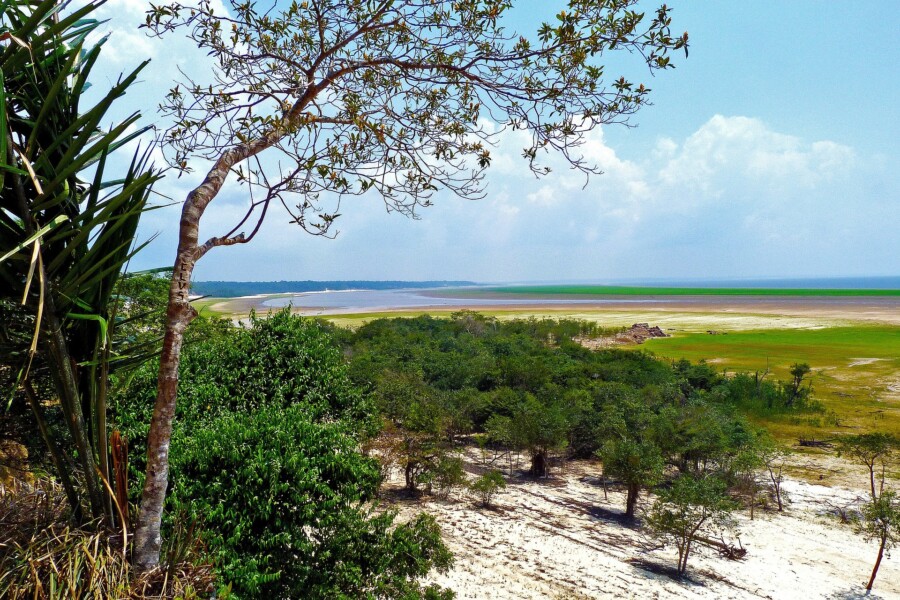The Amazon rainforest experienced its worst drought on record in 2023, causing devastating effects on villages, wildlife, and vegetation. Scientists are concerned that these events are a warning sign that the Amazon is nearing a point of no return. Oliveira Tikuna, a resident of a village in the middle of the forest, expressed his disbelief at the severity of the drought, stating that he had never seen anything like it before. The lack of water has led to spoiled crops and increased isolation for the villagers. The drought is attributed to the cyclical El Niño weather pattern, exacerbated by climate change.
Flávia Costa, a plant ecologist, who has been studying the rainforest for 26 years, explains that each drought has been stronger than the previous one, causing significant damage to plant life. The 2015 “Godzilla drought” alone killed billions of trees and plants. The Amazon rainforest is not only a biodiversity hotspot but also a crucial carbon sink, storing around 150 billion tonnes of carbon. Scientists fear that if deforestation reaches 25% and global temperatures rise by 2-2.5°C, the forest will reach a tipping point and transform into a savannah.
Brazilian climatologist Carlos Nobre expresses his increased concern about the future of the Amazon, especially considering the lack of progress in reducing greenhouse gas emissions. Currently, 17% of the Amazon has been deforested, and the global temperature is already 1.1-1.2°C above pre-industrial levels. However, there is hope as deforestation rates have decreased in all Amazon countries, and there is a commitment to reaching zero deforestation by 2030.
While some scientists believe that parts of the forest will survive even if the tipping-point conditions occur, signs of degradation are evident everywhere. Small fires set for land clearing purposes have spread out of control, affecting untouched or primary forest areas. Additionally, hundreds of dolphins have been found dead in lakes due to high water temperatures. The changing climate and its impact on the Amazon have shocked researchers and residents alike, emphasizing the urgent need to protect and preserve the rainforest.
Original news source: Amazon drought: ‘We’ve never seen anything like this’ (BBC)
🎧 Listen:
Slow
Normal
Fast
📖 Vocabulary:
| 1 | exacerbated | Made worse or more severe |
| 2 | biodiversity | The variety of plant and animal life in a particular habitat |
| 3 | deforestation | The process of clearing forests or trees |
| 4 | climatologist | A scientist who studies the climate and its variations |
| 5 | savannah | A grassy plain in tropical and subtropical regions, with few trees |
| 6 | degradation | The process of declining in quality or condition |
| 7 | tipping point | A critical threshold that, once crossed, leads to a significant change in the state or dynamics of a system |
| 8 | drought | A prolonged period of abnormally low rainfall, leading to a shortage of water |
| 9 | carbon sink | A natural environment that absorbs more carbon dioxide from the atmosphere than it releases |
| 10 | isolation | The state of being remote or set apart |
| 11 | urgency | The need for immediate action or attention |
| 12 | vegetation | The plants, especially the trees and shrubs, of an area or region |
| 13 | hotspot | A place of significant activity, interest, or popularity |
| 14 | ecologist | A scientist who studies the relationships between organisms and their environments |
| 15 | greenhouse gas emissions | The release of gases into the Earth’s atmosphere that trap heat and contribute to global warming |
Group or Classroom Activities
Warm-up Activities:
– News Summary
Instructions:
1. Divide the students into pairs or small groups.
2. Give each group a copy of the article.
3. Ask each group to read the article and summarize the main points in 3-4 sentences.
4. Have each group present their summaries to the class.
– Opinion Poll
Instructions:
1. Divide the students into pairs.
2. Assign one student in each pair to be the interviewer and the other to be the interviewee.
3. Give the interviewers a list of questions related to the article (e.g., Do you think the Amazon rainforest is in danger? What do you think should be done to protect it?).
4. The interviewers should ask the questions to their partners and record their responses.
5. After the interviews, have a class discussion where students share their partner’s opinions and discuss the different viewpoints.
– Vocabulary Pictionary
Instructions:
1. Write a list of vocabulary words from the article on the board (e.g., drought, biodiversity, deforestation).
2. Divide the students into small groups.
3. Give each group a piece of paper and a pen.
4. In each round, one student from each group will choose a word from the list and draw a picture to represent it.
5. The other students in the group must guess the word based on the drawing.
6. The group that guesses correctly gets a point.
7. Continue playing until all the words have been drawn.
– Pros and Cons
Instructions:
1. Divide the students into small groups.
2. Assign each group a role: pro or con.
3. Give the groups some time to discuss and brainstorm arguments for their assigned position regarding the future of the Amazon rainforest.
4. Have each group present their arguments to the class.
5. Encourage a class discussion where students can challenge and debate each other’s points.
– Future Predictions
Instructions:
1. Write the following question on the board: “What do you think will happen to the Amazon rainforest in the next 10 years?”
2. Divide the students into pairs.
3. In their pairs, ask the students to discuss their predictions for the future of the Amazon rainforest based on the information in the article.
4. After the discussion, have each pair share their predictions with the class.
5. Encourage a class discussion where students can compare and analyze the different predictions.
🤔 Comprehension Questions:
1. What were the effects of the worst drought on record in the Amazon rainforest?
2. How has the lack of water affected the villagers in the Amazon rainforest?
3. What is the cause of the drought in the Amazon rainforest?
4. How has each drought in the Amazon rainforest been compared to the previous one?
5. What is the significance of the Amazon rainforest as a carbon sink?
6. What is the tipping point for the Amazon rainforest to transform into a savannah?
7. What is the current state of deforestation in the Amazon rainforest?
8. What are some examples of the degradation caused by climate change in the Amazon rainforest?
Go to answers ⇩
🎧✍️ Listen and Fill in the Gaps:
The Amazon rainforest experienced its worst drought on record in 2023, causing devastating (1)______ on (2)______, wildlife, and vegetation. Scientists are concerned that these (3)______ are a warning sign that the Amazon is nearing a point of no return. Oliveira Tikuna, a resident of a village in the middle of the forest, expressed his disbelief at the severity of the drought, stating that he had never seen anything like it before. The lack of water has led to spoiled crops and increased isolation for the (4)______. The drought is attributed to the cyclical El Niño weather pattern, exacerbated by climate change.
(5)______ Costa, a plant ecologist, who has been studying the (6)______ for 26 years, explains that each drought has been stronger than the previous one, causing significant damage to plant life. The 2015 “Godzilla drought” alone killed billions of trees and plants. The Amazon rainforest is not only a biodiversity hotspot but also a crucial carbon sink, (7)______ around 150 billion tonnes of carbon. (8)______ fear that if deforestation reaches 25% and global temperatures rise by 2-2.5°C, the forest will (9)______ a tipping point and transform into a savannah.
Brazilian (10)______ Carlos Nobre expresses his increased concern about the future of the Amazon, especially considering the lack of progress in reducing greenhouse gas (11)______. Currently, 17% of the Amazon has been deforested, and the global temperature is already 1.1-1.2°C above pre-industrial (12)______. However, there is hope as deforestation rates have decreased in all Amazon countries, and there is a commitment to reaching zero deforestation by 2030.
While some scientists believe that (13)______ of the forest will survive even if the tipping-point conditions occur, signs of degradation are evident everywhere. Small fires set for land clearing purposes have spread out of control, affecting untouched or (14)______ forest areas. Additionally, hundreds of dolphins have been found dead in (15)______ due to high water temperatures. The changing climate and its (16)______ on the Amazon have shocked researchers and residents alike, emphasizing the urgent need to protect and preserve the rainforest.
Go to answers ⇩
💬 Discussion Questions:
Students can ask a partner these questions, or discuss them as a group.
1. What is the significance of the Amazon rainforest?
2. How would you feel if you lived in a village in the Amazon and experienced a severe drought?
3. Do you think the drought in the Amazon is a result of climate change? Why or why not?
4. What do you think would happen if the Amazon rainforest reached a tipping point and transformed into a savannah?
5. How do you feel about the current progress in reducing greenhouse gas emissions?
6. What are some potential consequences of deforestation in the Amazon?
7. Do you think it is possible to reach zero deforestation in the Amazon by 2030? Why or why not?
8. How do you think the changing climate is affecting the wildlife in the Amazon?
9. What measures do you think should be taken to protect and preserve the rainforest?
10. How do you think the drought and its effects on the Amazon will impact the global ecosystem?
11. Why do you think small fires set for land clearing purposes have spread out of control in the Amazon?
12. How do you think the changing climate in the Amazon will affect indigenous communities?
13. Do you think the international community is doing enough to address the issues facing the Amazon? Why or why not?
14. How would you feel if you saw the effects of deforestation and climate change firsthand in the Amazon?
15. What do you think individuals can do to contribute to the protection and preservation of the rainforest?
Individual Activities
📖💭 Vocabulary Meanings:
Match each word to its meaning.
Words:
1. exacerbated
2. biodiversity
3. deforestation
4. climatologist
5. savannah
6. degradation
7. tipping point
8. drought
9. carbon sink
10. isolation
11. urgency
12. vegetation
13. hotspot
14. ecologist
15. greenhouse gas emissions
Meanings:
(A) A place of significant activity, interest, or popularity
(B) The plants, especially the trees and shrubs, of an area or region
(C) The need for immediate action or attention
(D) A scientist who studies the relationships between organisms and their environments
(E) A grassy plain in tropical and subtropical regions, with few trees
(F) Made worse or more severe
(G) A natural environment that absorbs more carbon dioxide from the atmosphere than it releases
(H) The state of being remote or set apart
(I) A prolonged period of abnormally low rainfall, leading to a shortage of water
(J) The release of gases into the Earth’s atmosphere that trap heat and contribute to global warming
(K) A critical threshold that, once crossed, leads to a significant change in the state or dynamics of a system
(L) The process of clearing forests or trees
(M) The variety of plant and animal life in a particular habitat
(N) The process of declining in quality or condition
(O) A scientist who studies the climate and its variations
Go to answers ⇩
🔡 Multiple Choice Questions:
1. When did the Amazon rainforest experience its worst drought on record?
(a) 2015
(b) 2030
(c) 2023
(d) 2010
2. What are the devastating effects of the drought on the Amazon rainforest?
(a) Villages, rivers, and mountains
(b) Villages, deserts, and oceans
(c) Villages, cities, and lakes
(d) Villages, wildlife, and vegetation
3. What is the main cause of the drought in the Amazon rainforest?
(a) Deforestation and pollution
(b) The cyclical El Niño weather pattern exacerbated by climate change
(c) Earthquakes and volcanic eruptions
(d) Overpopulation and industrialization
4. How much of the Amazon rainforest has been deforested currently?
(a) 17%
(b) 25%
(c) 10%
(d) 50%
5. How much carbon does the Amazon rainforest store?
(a) Around 100 billion tonnes
(b) Around 150 billion tonnes
(c) Around 200 billion tonnes
(d) Around 50 billion tonnes
6. What will happen if deforestation reaches 25% and global temperatures rise by 2-2.5°C?
(a) The forest will become a desert
(b) The forest will disappear completely
(c) The forest will become a tropical rainforest
(d) The forest will transform into a savannah
7. What is the commitment for reaching zero deforestation in the Amazon?
(a) By 2023
(b) By 2040
(c) By 2030
(d) By 2050
8. What is one of the signs of degradation in the Amazon rainforest?
(a) Small fires spreading out of control
(b) Increased rainfall and flooding
(c) Decreased temperatures and snowfall
(d) Decreased wildlife and vegetation
Go to answers ⇩
🕵️ True or False Questions:
1. The lack of water has led to spoiled crops and increased isolation for the villagers.
2. The drought caused devastating effects on villages, wildlife, and vegetation.
3. The Amazon rainforest is a crucial carbon sink, storing around 150 billion tonnes of carbon.
4. Oliveira Tikuna, a visitor of a village in the middle of the desert, expressed disbelief at the severity of the flood.
5. Scientists are reassured that these events are not a warning sign that the Amazon is nearing a point of no return.
6. The Amazon rainforest experienced its mildest drought on record in 2023.
7. Each drought in the Amazon has been stronger than the previous one, causing significant damage to plant life.
8. The flood is attributed to the consistent El Niño weather pattern, alleviated by climate change.
Go to answers ⇩
📝 Write a Summary:
Write a summary of this news article in two sentences.
Check your writing now with the best free AI for English writing!
Writing Questions:
Answer the following questions. Write as much as you can for each answer.
Check your answers with our free English writing assistant!
1. What were the devastating effects of the worst drought on record in the Amazon rainforest?
2. How has the cyclical El Niño weather pattern contributed to the severity of the drought in the Amazon?
3. What is the potential consequence if deforestation reaches 25% and global temperatures rise by 2-2.5°C in the Amazon?
4. How much of the Amazon has already been deforested, and what is the current global temperature compared to pre-industrial levels?
5. What are some signs of degradation in the Amazon rainforest caused by the changing climate?
✅ Answers
🤔✅ Comprehension Question Answers:
1. The effects of the worst drought on record in the Amazon rainforest include devastating effects on villages, wildlife, and vegetation.
2. The lack of water has led to spoiled crops and increased isolation for the villagers in the Amazon rainforest.
3. The drought in the Amazon rainforest is attributed to the cyclical El Niño weather pattern, exacerbated by climate change.
4. Each drought in the Amazon rainforest has been stronger than the previous one, causing significant damage to plant life.
5. The Amazon rainforest is a crucial carbon sink, storing around 150 billion tonnes of carbon.
6. The tipping point for the Amazon rainforest to transform into a savannah is if deforestation reaches 25% and global temperatures rise by 2-2.5°C.
7. Currently, 17% of the Amazon has been deforested.
8. Some examples of the degradation caused by climate change in the Amazon rainforest include small fires spreading out of control, affecting untouched or primary forest areas, and the death of hundreds of dolphins in lakes due to high water temperatures.
Go back to questions ⇧
🎧✍️✅ Listen and Fill in the Gaps Answers:
(1) effects
(2) villages
(3) events
(4) villagers
(5) Flávia
(6) rainforest
(7) storing
(8) Scientists
(9) reach
(10) climatologist
(11) emissions
(12) levels
(13) parts
(14) primary
(15) lakes
(16) impact
Go back to questions ⇧
📖💭✅ Vocabulary Meanings Answers:
1. exacerbated
Answer: (F) Made worse or more severe
2. biodiversity
Answer: (M) The variety of plant and animal life in a particular habitat
3. deforestation
Answer: (L) The process of clearing forests or trees
4. climatologist
Answer: (O) A scientist who studies the climate and its variations
5. savannah
Answer: (E) A grassy plain in tropical and subtropical regions, with few trees
6. degradation
Answer: (N) The process of declining in quality or condition
7. tipping point
Answer: (K) A critical threshold that, once crossed, leads to a significant change in the state or dynamics of a system
8. drought
Answer: (I) A prolonged period of abnormally low rainfall, leading to a shortage of water
9. carbon sink
Answer: (G) A natural environment that absorbs more carbon dioxide from the atmosphere than it releases
10. isolation
Answer: (H) The state of being remote or set apart
11. urgency
Answer: (C) The need for immediate action or attention
12. vegetation
Answer: (B) The plants, especially the trees and shrubs, of an area or region
13. hotspot
Answer: (A) A place of significant activity, interest, or popularity
14. ecologist
Answer: (D) A scientist who studies the relationships between organisms and their environments
15. greenhouse gas emissions
Answer: (J) The release of gases into the Earth’s atmosphere that trap heat and contribute to global warming
Go back to questions ⇧
🔡✅ Multiple Choice Answers:
1. When did the Amazon rainforest experience its worst drought on record?
Answer: (c) 2023
2. What are the devastating effects of the drought on the Amazon rainforest?
Answer: (d) Villages, wildlife, and vegetation
3. What is the main cause of the drought in the Amazon rainforest?
Answer: (b) The cyclical El Niño weather pattern exacerbated by climate change
4. How much of the Amazon rainforest has been deforested currently?
Answer: (a) 17%
5. How much carbon does the Amazon rainforest store?
Answer: (b) Around 150 billion tonnes
6. What will happen if deforestation reaches 25% and global temperatures rise by 2-2.5°C?
Answer: (d) The forest will transform into a savannah
7. What is the commitment for reaching zero deforestation in the Amazon?
Answer: (c) By 2030
8. What is one of the signs of degradation in the Amazon rainforest?
Answer: (a) Small fires spreading out of control
Go back to questions ⇧
🕵️✅ True or False Answers:
1. The lack of water has led to spoiled crops and increased isolation for the villagers. (Answer: True)
2. The drought caused devastating effects on villages, wildlife, and vegetation. (Answer: True)
3. The Amazon rainforest is a crucial carbon sink, storing around 150 billion tonnes of carbon. (Answer: True)
4. Oliveira Tikuna, a visitor of a village in the middle of the desert, expressed disbelief at the severity of the flood. (Answer: False)
5. Scientists are reassured that these events are not a warning sign that the Amazon is nearing a point of no return. (Answer: False)
6. The Amazon rainforest experienced its mildest drought on record in 2023. (Answer: False)
7. Each drought in the Amazon has been stronger than the previous one, causing significant damage to plant life. (Answer: True)
8. The flood is attributed to the consistent El Niño weather pattern, alleviated by climate change. (Answer: False)
Go back to questions ⇧













